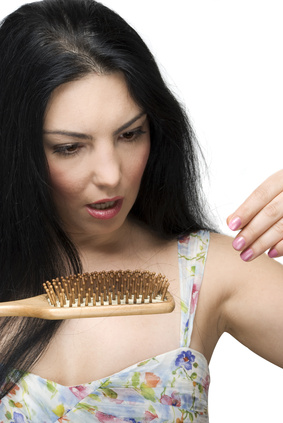Loss of hair in women can appear in a number of different ways and how it happens will largely depend on the basis of the problem. Hair loss in women can come about gradually or suddenly and can affect the entire body or just the scalp. Hair loss can be permanent or temporary.

Androgenetic Alopecia is the most common kind of hair loss in women and the condition is also referred to as female pattern hair loss (FPHL). FPHL is characterized by thinning hair predominantly on the sides and top of the head. Approximately one-third of all genetically vulnerable women are affected by this condition; however, it most commonly surfaces after menopause. Individuals typically lose between 100 and 125 hairs everyday and this is considered normal. Fortunately, the lost hairs are naturally replaced through regrowth. True hair loss in women happens when more than 125 hairs fall out daily and the lost hairs do not grow back. From a genetic standpoint, the loss of hair in women can be inherited from the bloodline of either parent.
There are certain distinct symptoms and signs that indicate hair loss in women and they include:
Abrupt Loosening of the Hair
An emotional or physical shock could result in the loosening of the hair. Handfuls of hair might come out when the hair is being washed or combed, even with gentle tugging. Overall hair thinning is usually the result of this type of hair loss.
Gradual Hair Thinning on the Top of the Head
This type of hair loss is the most common and it affects both women and men. For men, their hair frequently starts receding from the forehead, while women normally retain their hairlines but experience hair loss around the part in their hair.
Hair Loss All Over the Body
Some medical conditions and treatments can cause hair to fall off the entire body. However, after the treatments have ended, the hair typically grows back.
Patchy or Circular Bald Spots
A number of women experience bald spots that are usually around an inch in size. This kind of hair loss typically affects only the scalp but from time to time, some women experience the loss of their eyebrows. In addition, the skin might become painful or itchy prior to the hair falling out.
Below are detailed accounts of some of the factors that cause hair loss in women:
Medical conditions
There is a number of different medical conditions that can result in hair loss in women and they include:
Thyroid Problems
The hormone levels in the body are regulated with the help of the thyroid gland. When the gland is not properly functioning, hair loss could result.
Scalp Infections
Ringworm and other infections can invade the hair and scalp and result in hair loss. As soon as the infections have been treated, the hair normally grows back.
Alopecia Areata
This is a disease that occurs when the immune system attacks hair follicles and causes smooth, round hair loss patches.
Other Disorders of the Skin
Medical conditions that can result in scarring, such as some types of lupus and lichen planus can cause permanent hair loss in the areas where the scars occur.
Hormonal Factors
In individuals who are genetically susceptible to hair loss, certain sex hormones can trigger a specific pattern of permanent hair loss. Even though this type of hair loss can start as early as puberty, it typically affects menopausal women. Changes and imbalances in the hormones can result in temporary hair loss as well. This could be caused by the onset of menopause, divorce or the ending of a relationship, losing a loved one to death, childbirth, pregnancy or the discontinuation of oral contraceptives.
Medications
Hair loss in women can result from drugs used to treat certain medical or clinical conditions such as:
- Depression
- Cancer
- Arthritis
- High blood pressure
- Heart problems
Other causes of loss of hair in women include:
An Emotional or Physical Shock
Several months following an emotional or physical shock, a number of individuals start to experience noticeable thinning of the hair. The loss of a loved one to death, divorce of the end of a relationship, a high fever and excessive weight loss are examples of emotional and physical changes that could result in hair loss.
Certain Hairstyles
In cases where the hair is too tightly pulled into hairstyles such as cornrows or pigtails, traction hair loss could occur.
Hair-pulling Disorder
This is a form of mental illness that causes individuals to have the overpowering urge to pull their hair out, whether it is from their eyebrows, their scalp or other parts of the body. Pulling the hair from the scalp frequently leaves the head with patchy bald spots.
While hair loss in women can be a traumatizing experience, there are many available treatments that can be used to reverse hair loss.
